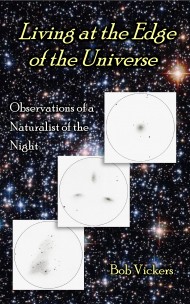Here are some GG&C observations I did a couple of weeks ago as well as a couple from over five years ago.
The first is Astronomical League Trio #10, except that I could not see one member of the trio (NGC 1062). This galaxy is listed as NGC 1062 in the GG&C booklet sold by the A.L. but is listed as UGC 2201 in Uranometria and in a January 2010 Sky & Telescope article by Ken Hewitt-White titled Galaxy Groups in Triangulum. A fourth galaxy (which is actually part of Trio #9), NGC 1060, was easily visible at the edge of the field of view.
The next group was Additional #9 (or the NGC 1129 group). I managed to spot all seven of the main galaxies in this cluster which consisted of one large central galaxy (NGC 1129) and six smaller galaxies. One of the smaller galaxies, MGC +7-7-3 is superimposed on NGC 1129.
 Astronomical League Additional Galaxy Group #9 (aka NGC 1129 Group). Copyright (c) 2013 Robert D. Vickers, Jr.
Astronomical League Additional Galaxy Group #9 (aka NGC 1129 Group). Copyright (c) 2013 Robert D. Vickers, Jr.My luck was not nearly as good with the next cluster, Abell 397. In fact I didn’t have any luck at all because I could not see any of its members. Apparently all were too dim.
I am including two observations that I did back in 2007. The first is for Additional #47, also known as the NGC 7331 group or the Deerlick Group. NGC 7331 is a foreground galaxy about 50 million light years distant whereas the remaining small galaxies are in the 300-400 million light year range. These smaller galaxies have the charming, if somewhat itchy, title of “the Fleas.”
 Astronomical League Additional Galaxy Group #47 (aka The Deerlick Group or NGC 7331 &The Fleas). Copyright (c) 2013 Robert D. Vickers, Jr.
Astronomical League Additional Galaxy Group #47 (aka The Deerlick Group or NGC 7331 &The Fleas). Copyright (c) 2013 Robert D. Vickers, Jr.Lastly, the other observation from 2007, is the Hickson 92 galaxy group (also known as Stephan’s Quintet). Four out of the five galaxies in this group are about 282 million light years away while one (NGC 7320) is about 56 million light years away. All are very faint. (For you trivia buffs out there, in the opening scenes of the movie It’s a Wonderful Life staring Jimmy Stewart, the angels are really the galaxies of Stephan’s Quintet.)
On the nights I was out observing two weeks ago I made a point to look for the zodical light, sunlight reflecting off of interplanetary dust. It is very apparent on moonless evenings this time of year. A pretty obvious, tall, leftward leaning pyramid of light in the west-southwest, it could easily be mistaken for light pollution. It points along the ecliptic and can be traced very high into the sky (I estimated it as between 50 and 70 degrees upward from the horizon.) According to Alan MacRobert of Sky & Telescope magazine, it is “the brightest thing in the solar system after the Sun.” The light is just spread out over a very large area so it appears dim.

